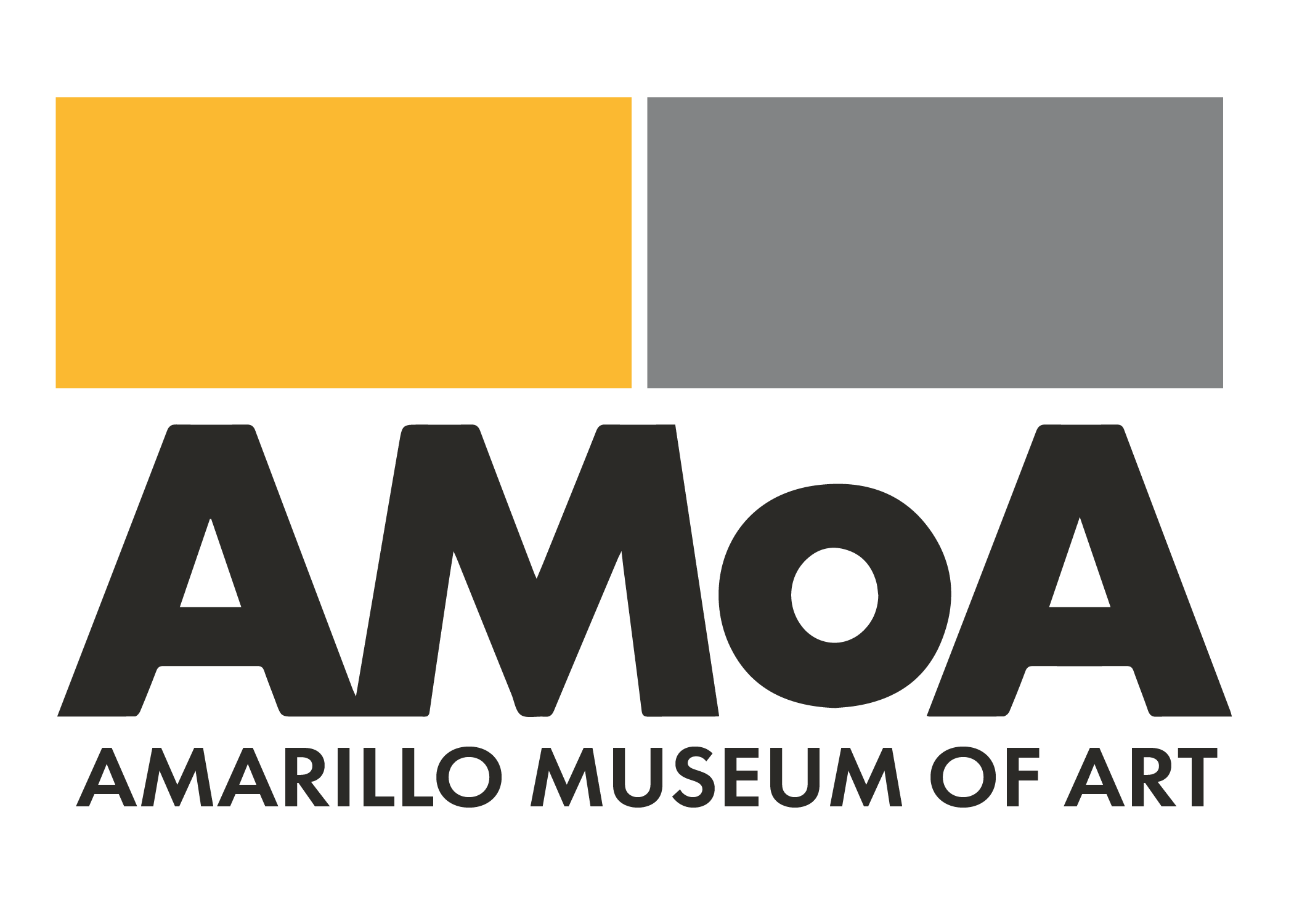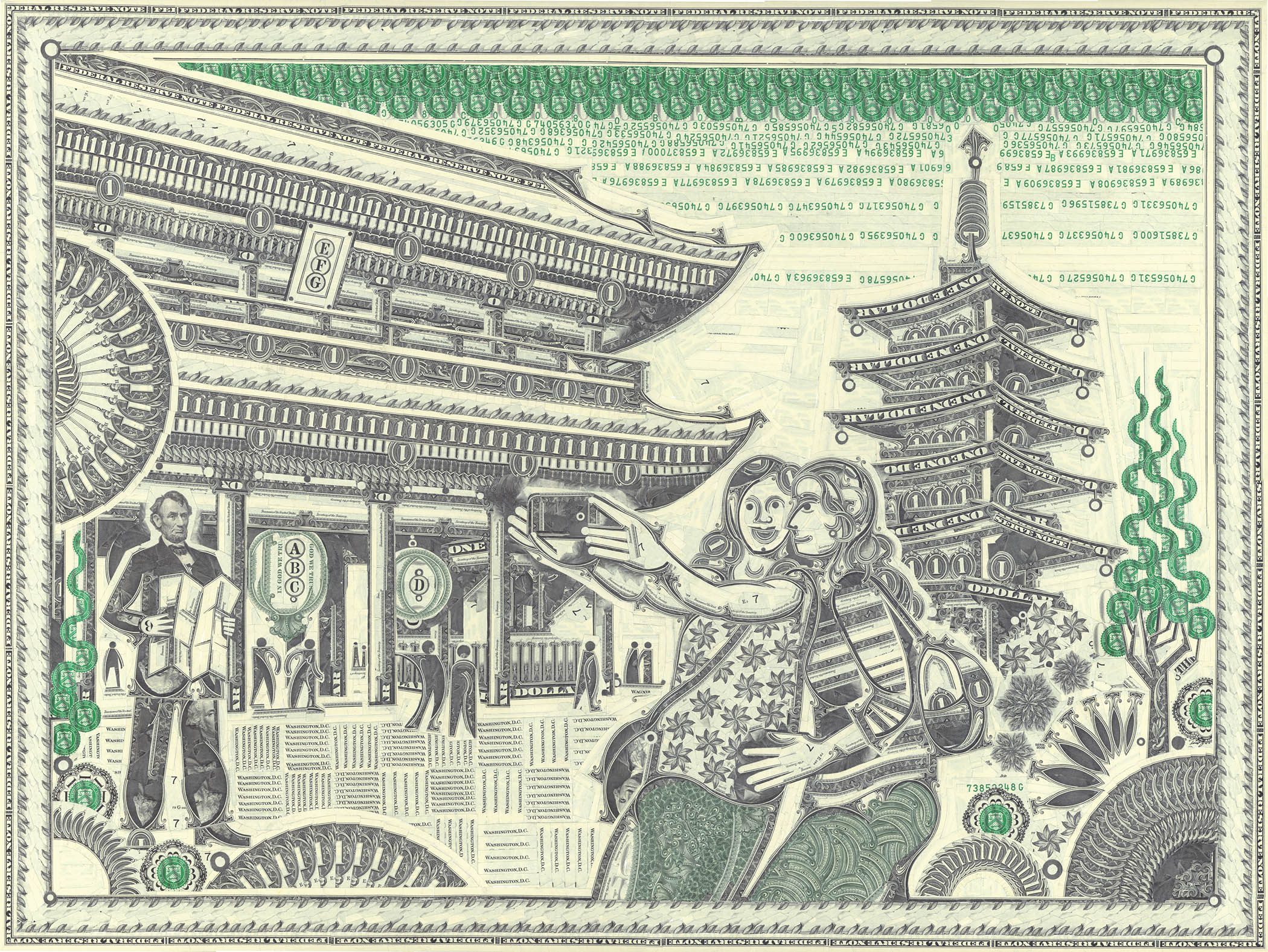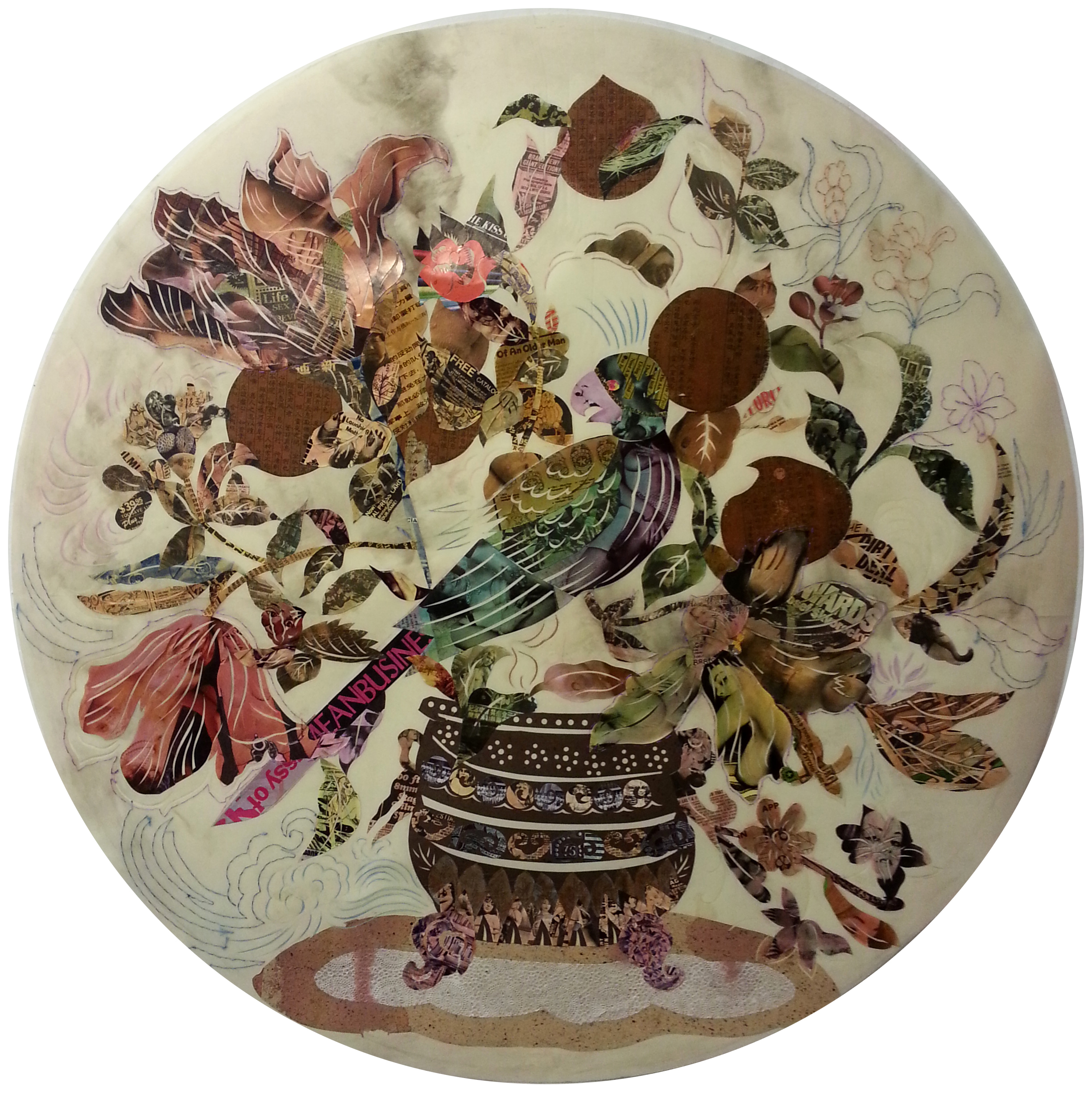FRANCESCA PASTINE ARTFORUM 50 Hindsight, Mask Series 2014 cut Artforum magazine, Plexiglass 15 x 16.25 x 6 inches Courtesy of Eleanor Harwood Gallery, San Francisco, CA
CUT UP CUT OUT
July 6 - September 15, 2019
Cut Up/Cut Out is an exhibition of national and international artists who explore captivating methods of decorative piercing and cutting, using a wide range of media from paper and plastic to metal and rubber. The transformative nature of cutting into and through a surface provides endless possibilities for converting the material from opaque to transparent, from flat to sculptural, from rigid to delicate, and from ordinary to exquisite. The process and precision required for this method of art-making is laborious, technically demanding, and always astonishing. This exhibition honors both innovation and tradition with a selection of over 100 artworks by 51 artists representing diverse styles and techniques.
EXHIBITION SPONSORS
Rachelle and Jake Tuls
Amarillo National Bank
Dr. Kent Roberts and Ilene Roberts Ballet Foundation
Cut Up/Cut Out is a contemporary view of an ancient art practice that has evolved over thousands of years. This exhibition, which includes national and international artists, honors both tradition and innovation with a selection of over one hundred artworks by 51 artists representing diverse techniques and approaches to making art.
My interest in the art of paper cutting started sixteen years ago when I organized a 20-year retrospective of Bay Area artist Irene Pijoan’s (1953-2004) work. In 2000, Irene was in the midst of a ground-breaking body of large-scale cut paper pieces comprised of a complex network of patterns, words, and numbers. The work was immense and staggeringly beautiful. Some of the pieces stretched from floor to ceiling, and she often painted the back of pieces bright colors –like neon pink– creating an illuminated reflection against the wall. Sadly, we lost Irene to a long-fought battle with cancer, but we remember her with love and admiration. I dedicate this exhibition to her extraordinary creative force and vision.
Visually diverse, the artworks in Cut Up/Cut Out range in size from an intimate three inches to sprawling and complex installations, and they represent an abundance of conceptual ideas. The artists address our relationship with nature and environmental issues, personal and political narratives, architecture, fantasy, and abstract or formal ideas—with many intersections.
When you explore the art of paper cutting, you travel the world and encounter some of the earliest examples of human expression and innovation. Sources point to 6th-century China as the birthplace of cut paper artwork. Originally a decorative handcraft for women, Chinese paper cutting eventually expanded into rural areas, becoming a staple at religious ceremonies and festivals. Cut Up/Cut Out artist Xin Song is inspired by the delicate paper-cut works of local Chinese farmers. She says her work is a bridge between an imaginary world, Chinese tradition, and her everyday life in America.
Paper art enthusiasts have also traced paper cutting to the Americas, where the Aztecs cut figures into the bark of the Amate tree in pre-contact times, which is characterized as the era before European colonization in the 16th century. Eventually, paper cutting spread to the rest of the world, creating a new wave of enchanting and significant folk art traditions. As history has unfolded, the exploration of media to cut into or pierce has grown to include cloth, wood, metal, and rubber, and you will see many of these art forms in Cut Up/Cut Out.
Cut Up/Cut Out is a reflection of the rich and lasting reference to an art practice that is global and enduring. My research into this art practice was fascinating, and when I began to curate the exhibition several themes began to emerge for many works in the show: Advancing Tradition, The Excavators, and Global Zeitgeist.
ADVANCING TRADITION
To this day, the traditional Japanese cut paper techniques kamikiri (performance art involving the cutting of paper into artwork) and kirie (paper cutouts) continue to inspire artists. We see glimmers of this tradition in the work of Kako Ueda, who creates meticulously cut paper images inspired by natural history and our relationship to the natural world. Rogan Brown is also drawn to nature as his primary source of imagery, from snowflakes and cell structures to ocean algae and the galaxy. His complex structures of organized chaos encourage viewers to stop and witness nature’s beauty and fragility. Maude White taps into the centuries-old tradition of storytelling with paper, making thousands of cuts into its surface to create lacy flowers and portraits. Annie Vought’s arduous process of recreating handwritten letters by cutting away the negative space is a meditative investigation into the oversaturation of words in our contemporary lives. The result is an intimate, lace-thin artwork—like a visual whisper.
Paper was imported from China to Mexico in the 18th century, and Mexican artisans developed the tradition of papel picado, a technique using chisels to create up to 40 paper banners at a time. This well-loved tradition is till used today for Day of the Dead and other celebrations, and is fully embraced by San Francisco artist Carmen Lomas Garza to create her metal and paper cutouts. Garza’s work celebrates Mexican-American history and culture, and is inspired by the late 1960s Chicano Movement and her own childhood in South Texas. Donna Ruff’s work is reminiscent of papel picado, but instead of tissue paper she uses the front page of the New York Times as her primary surface, creating patterns and a subsequent narrative around headlines and photographic articles.
THE EXCAVATORS
Many artists in the exhibitions act as explorers or scientists, cutting away layers of paper to discover what lies between and how they may transform and object into something entirely new. Francesca Pastine has been excavating ARTFORUM magazines for years, repurposing the elite art magazine into a power object—a mask or totem—dedicated to the artist. Charles Clary addresses his loss of both parents to cancer by tunneling through layers of drywall and wallpaper to build an exquisite maze of colorful, cut patterns. Ana Bidart carves into rolls of printing paper, creating a clean, minimal surface that resembles the strata of a geologic formation.
GLOBAL ZEITGEIST
The transformative nature of cutting into and through a surface provides endless possibilities for converting the material from opaque to transparent, from flat to sculptural, from rigid to delicate, and from ordinary to exquisite. The process and precision required for this method of art-making is laborious, technically demanding, and bewildering.
The artists in Cut Up/Cut Out use an astonishing range of materials reflecting the spirit of the time in which we live. We are awed by Hillary Waters Fayle’s fragile, hand-sized leaves cut into abstract patterns, and Wim Delvoye’s intensely detailed lattice-worked car tires. Justine Khamara plays with suspense with portraits that are sliced and reassembled in startling new ways, and Nikki Rosato transforms paper maps into figurative profiles with the land cut away, leaving the road lines to resemble veins beneath the skin. Karen Margolis’ topographical pieces are painstakingly constructed with stacks of vibrantly painted maps, each layer pierced with hundreds of holes and resembling a microscopic sector of the human vascular system. Mayumi Hamanaka’s series of fictional cut-out topographical maps are rendered to look like abstract landscapes, but in fact they are intensely personal explorations about political strife and portraits of Japan, her homeland. Another Japanese artist, Yuken Teruya carefully cuts away at the retail bags of high end stores to create dioramas that address the effects of consumerism and globalism.
Cut Up/Cut Out offers some wonderful surprises where the base material and the cut-out image are entirely mismatched. Cal Lane’s 30-gallon oil drum and land mines cut with delicate filigreed décor offer an immediate and unsettling disconnect. Blending violence and beauty, Mounir Fatmi’s imposing circular saw blade is punctured with a calligraphic Arabic inscription from the Qur’an.
Over the past several years, Adriane Colburn has developed a series of sprawling installations based on the complex relationship between human infrastructure, earth systems, technology, and the natural world. Her large-scale installation of cut paper wall-works include photographs, drawings, video, and projected light. Chris Natrop, also working large and wielding a free-style knife, creates exquisitely tangled, hybrid landscapes based on a post-apocalyptic vision.
The narrative story in all of its forms also holds court in Cut Up/Cut Out. Adrienne Heloise creates dramatic, sometimes naughty images that reenact historical scenes of battle and hunting, using cut paper and collage that is up to 12 layers deep. Rob Ryan’s charming and poetic narratives are everyday stories about universal themes that span love, loss, longing, and death.
With this exhibition we can see that the long history, tradition, and art of paper cutting now find a rich synergy with our contemporary art world. The process and art of cutting—complex, delicate, beautiful, tedious, consuming, frustrating, and awesome—can be seen as a metaphor for life itself and the acts of creating: in art, work, and family.
Carrie Lederer, Curator of Exhibitions and Programs
Bedford Gallery at the Lesher Center for the Arts, Walnut Creek, CA
Cut Up/Cut Out is a nationally traveling exhibition. After its debut at Bedford Gallery in 2016 the exhibition will travel through 2020 to the following venues: Bellevue Arts Museum (Bellevue, WA), Huntsville Museum of Art (Huntsville, AL), Pensacola Museum of Art (Pensacola, FL), Ellen Noël Art Museum(Odessa, TX), Museum of Art & Sciences (Daytona Beach, FL), Woodson Art Museum (Wausau, WI), Amarillo Museum of Art (Amarillo, TX), Art Museum of West Virginia University (Morgantown, WV), Lamont Gallery (Exeter, NH), Massillon Museum (Massillon, OH), and the Carnegie Arts Center (Turlock, CA).
Participating Artists
James Allen, Portland, OR
Ana Bidart, Mexico City, Mexico
Lucrezia Bieler, Tallahassee, FL
Tord Boontje, London, UK
Nathalie Boutté, Montreuil, France
Claire Brewster, London, UK
Robert Brinker, Denver, CO
Rogan Brown, Nimes, France
Sara Burgess, San Francisco, CA
Michael Buscemi, San Jose, CA
Charles Clary, Conway, SC
Adriane Colburn, San Francisco, CA
Wim Delvoye, Brighton, UK
Lorenzo Duran, Guadalajara, Spain
Mounir Fatmi, Paris, France
Hillary Waters Fayle, Richmond, VA
Adam Feibelman, San Francisco, CA
Carmen Lomas Garza, San Francisco, CA
Margaret Griffith, Altadena, CA
Mayumi Hamanaka, Richmond, CA
Adrienne Heloise, Oakland, CA
Meg Hitchcock, Brooklyn, NY
Justine Khamara, Melbourne, Australia
Kyong Ae Kim, San Francisco, CA
Will Kurtz, Brooklyn, NY
Lauren Kussro, Indianapolis, IN
Cal Lane, Putnam Valley, NY
Bovey Lee, Los Angeles, CA
Simone Lourenco, Brooklyn, NY
Karen Margolis, New York, NY
Chris Natrop, Los Angeles, CA
Amy Oates, Oakland, CA
Francesca Pastine, San Francisco, CA
Iréne Pijoan, 1953-2004
Nikki Rosato, Washington D.C.
Donna Ruff, Miami Beach, FL
Rob Ryan, London, UK
Lyndi Sales , Cape Town, South Africa
Gabriel Schama, Oakland, CA
Brian Singer, San Francisco, CA
Andy Singleton, Wakefield, England
Xin Song, New York, NY
Jen Stark, Los Angeles, CA
Janna Syvanoja, Helsinki, Finland
Yuken Teruya, New York, NY
Kako Ueda, Brooklyn, NY
Annie Vought, Oakland, CA
Mark Wagner, Lancaster, PA
Maude White, Hudson, NY
Barbara Wildenboer, Cape Town, South Africa
Ty Zemelsky, Durham, CT





















